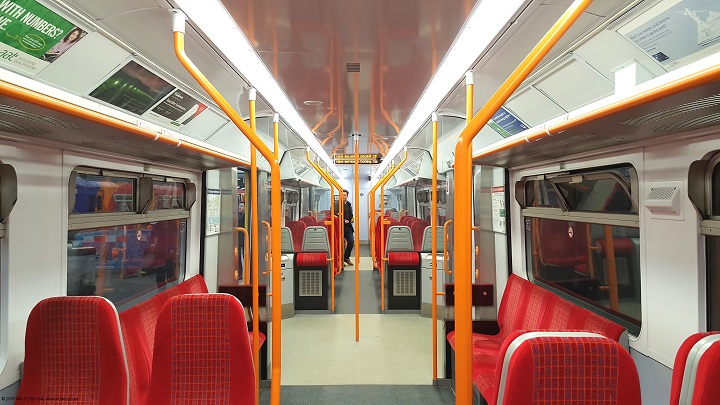The Class 456 was a two-carriage train that operated on our mainline suburban network between 2014 and 2022. We operated 24 of these trains between London Waterloo and:
- Dorking
- Chessington South
- Guildford (via Epsom, via Cobham & Stoke d'Abernon, and via Woking)
- Woking (stopping services)
- Hampton Court
- Shepperton (via Kingston and via Twickenham)
- Strawberry Hill (via Kingston and via Twickenham)
The Class 456 was built by British Rail Engineering Limited and entered service on lines in the South London area in 1991. The trains had two carriages and could operate "in multiple", which means that two trains could run together as a four-carriage train. They also worked with our Class 455 trains to form six- and ten-carriage trains before being retired in January 2022.

Train plan

How many seats does a Class 456 have?
A Class 456 has 110 Standard Class seats. There is no First Class. 14 seats are designated as priority seats.
How many cycles can a Class 456 carry?
A Class 456 can carry 2 cycles. They can't carry tandem bicycles or trailers. Find out more about our cycle policy.
How many wheelchair users can travel on a Class 456?
Two wheelchair users can travel safely on a Class 456.
What accessible features does the Class 456 have?
Our Class 456 trains have:
For physically disabled people:
- Power-operated external doors, which contrast with the rest of the train. At low platforms wheelchair users may have some difficulty reaching the door open buttons from outside the train.
- Large external door operation buttons, with what the button does clearly marked in English and Braille. They contrast with the door and light up when active.
- There are no lavatories on board these trains.
- Call for aid buttons near each wheelchair position, with direct communication to the guard.
- An on-board ramp with locking pins for the train that the crew are trained to deploy. The gap between the train and platform can often be difficult for wheelchair users and customers with limited leg and upper body strength. Assistance joining and leaving the train is available from the crew.
For D/deaf, hard-of-hearing, and sound-sensitive people
- Assistance dogs are welcome on board but must be kept on a lead.
- An on-board audiovisual announcement system in English. This system issues the stations where the train stops, as well as security and safety messages. The system can be overridden by the on-board crew.
- Our crew all carry smartphones, which you can use for alternative forms of communication if needed.
For blind, partially-sighted people, and photosensitive people
- Assistance dogs are welcome on board but must be kept on a lead.
- Large external door operation buttons, with what the button does clearly marked in English and Braille. They contrast with the door and light up when active. A chime will also sound when the doors have been activated, and an alarm will sound when they are closing.
- Unfortunately the nature of how our trains are powered means that we can't guarantee lighting will be flicker-free. Warm fluorescent lighting is used throughout. There are no diffusers on the lights.
For Autistic, anxious and Neurodiverse people
- Assistance dogs are welcome on board but must be kept on a lead.
- We welcome anxious or nervous travellers to try the train with us before making a journey. Our ambassador team will happily support individuals or groups at a station, navigating buying tickets, boarding trains, travelling, and seeking help if you need it.
- Our crew all carry smartphones, which you can use for alternative forms of communication if needed.
For people with severe allergies or who are immunocompromised
- These trains are cooled with natural ventilation.
- You're welcome to use a safety/particulate mask on board if you need to.
Header image: Hugh Llewelyn - Own work, CC BY-SA 2.0
Interior image: Richard Graham - Own work, CC BY-SA 4.0, Link





